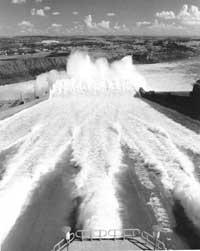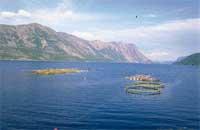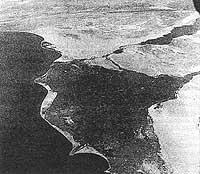Delta: river fighting the sea
2004/06/01 Roa Zubia, Guillermo - Elhuyar Zientzia Iturria: Elhuyar aldizkaria

The Mississippi River is slowly eating the American plain. The water flows next to the stream and precipitates further down. This matter is sedimented throughout the course of the river, but this effect is especially spectacular at the end of the route. The delta located southeast of New Orleans is growing.
Sure? Is it growing? The technicians who manage this area do not say so. What is happening?
Today, the Mississippi Delta is shaped like a bird's foot, formed by a land that has grown millennia forward. For geologists there is no doubt; the contribution of the river is more powerful than the 'defense' of the sea. It is understandable because the Gulf of Mexico sea is not very deep and not as strong as in the great oceans. In short, there the sea does not have much strength to cope with the sediments of Mississippi.
But, in addition to the influence of the sea, one must take into account that of man. To ensure sailability, the river has been channeled by man. Thus, no flooding occurs, except for natural catastrophe. But, in return, the river has been forced and the water has only one way to the sea. In addition, reservoirs have been built to feed irrigation systems with water. But that stops the matter dragged by water, since many do not reach the delta and the one who arrives is not distributed correctly. Finally, delta, instead of moving forward, is backing down.
Americans are proud of the Mississippi Delta, known as the New World Nile. Egypt's Nile River, however, has a very different delta.
Ancient delta

The Mediterranean has a lot of energy at the mouth of the Nile, eroding strongly. The delta of this river, like that of the river Rodano, has been originated by the waves of the sea, that is, instead of the river itself sediments the sand, the waves do it. The influence of the sea marks the appearance of the delta.
The relationship between man and the Nile delta is very old, in short, one of the most fertile lands in Africa. It is the origin of an ancient great civilization. The ancient Egyptians lived waiting for the annual flood, remaining in the subsoil for weeks, resulting in abundant harvests after drought. The life cycle of the Egyptians depended on the Delta water cycle.
But do not forget that it was they who made the first canalizations. They controlled the river. Currently, the river is divided into two, with two main exits. This and the Asuan reservoir do not allow the natural distribution of sediments. It is the same problem as Mississippi and many other great rivers.
Nilon, a sand barrier that protects the delta is in danger, the sea has begun to erode faster than in a natural state. Having the delta a very flat land, it would be very easy to cover it with sea water. But what can be done now? Putting limits on the sea? So far all buildings have generated more problems. (This problem is very serious, for example, in the Yellow River, in China; it is very exploited and, therefore, being one of the great rivers, hardly water reaches it.)
Waves and tides

This does not occur at all in the Rhine Delta, the Netherlands. This country is famous for its contribution to the river in the fight against the sea. Huge walls were built, dikes, which now live under the sea level, protected by those walls. In addition, land gained from the sea was dried for agriculture (famous polders).
But the influence of the sea is evident in other less human deltas. This influence can be that of the waves, as in Nile and Rodano, or that of the tides, as in the Niger River and the Bengal Delta.
The case of the Bengal delta is very striking. There, in the same delta, two great rivers of the Himalayas flow, the Ganges and Brahmaputra rivers. The tides of the Gulf of Bengal scourge the materials provided by the rivers before their sedimentation.
However, there is another reason why this delta is at the mercy of the sea: geologically it is very young, that is, it has just been born. India, coming from the south, hit Asia and the Ganges River emerged on the border between the two. Of course, India continues to move northeast, so the river delta has not always been in the same place. In the past both rivers went out to the sea separated, but the movement has united and a single delta has been created for both.
Protected spaces

The Bengal Delta is young. But you can also look for younger examples, supposedly the Ebro delta is a consequence of human activity five hundred or six hundred years ago. At the end of the Middle Ages many forests were cut to meet the needs of Castile wood, especially to build boats. Hundreds of trees were lost. And with the loss of trees came erosion. And the Ebro delta formed it the erosion material.
Currently, protected areas are located in the Ebro delta and other rivers. They are places where many species have refuge. They stand out more than the case of the Ebro, such as Guadalquivir or Rodano. In its deltas are the parks of Doñana and Camargue, respectively.
Other deltas in the world also have protected areas. Many of them have been declared natural or national parks, such as the deltas of Orino, Danube, Roanoke, etc. Note that deltas ecosystems are very special.
Estuaries
However, the mouth area of a river can be very varied. The word estuary collects some of these types and the Amazon River is an example.
In the estuary the mouth of the river creates a 'canal' type structure, but not in any way, largely closed. Place of confluence between the river and the sea, but protected in some way. There are no strong currents or deep waters. An estuary can be in a delta with the combined coast. For example, the mouth of the Colorado River is like this.

From a biological point of view, the advantage of the estuary is that it mixes salt and sweet water in a very quiet environment, collecting fertilizers from the sea and the river. It is an ideal place for the reproduction of fish and other species. In fact, there are many marine species that lay their eggs in the estuaries, where the young are born, grow there and when they mature they return to the sea. The eel is one of these animals.
Estuaries are very attractive places not only for many species, but also for humans, where thousands of cities have been built around estuaries. After all, they also protect the traffic of the boats, constituting beautiful natural ports. Probably one of the most prestigious estuaries in Europe is the Thames, cradle of the city of London.
The environmental situation of estuaries is not very good. Few resist the natural conditions, the larger ones do not. And not only because the cities were built there, since, as the manure picks up, the estuary also collects the consequences of the damage caused along the entire course of the river. Remains from any industrial area of the basin or a large city arrive at the estuary.
Is there a solution? There may be something local, but there are no high expectations for deltas and estuaries. It is clear that until the human population declines these two ecosystems, like many others, will not be recovered.
Appearance of a letter

In the deltas texts, Heterodotus, a Roman historian, inventor of the name, is always quoted. Apparently, he realized the triangular aspect of the Nile delta and came up with the Greek letter delta. However, not all deltas have that aspect, some are lengthened towards the sea, others inward, some are fan shaped, others seem braids, etc. But everyone gives a special shape to the coast.
Deltas full of people Where do people focus on this world? The human being lives almost everywhere, but especially on the coast and on the banks of the rivers when he has been able. It is not strange, therefore, that deltas are overcrowded. They are very fertile natural lands, since the fertilizers provided by the river accumulate in flat areas. One of the most important civilizations of antiquity advanced around the Nile and the population increased considerably, among other things, in delta. It is a still fertile place where there are still many people. About 1,600 people per square kilometer live in the Nile delta, four times more than in Holland. In some cases, such as the Yellow River or the Bengal River, the population has been affected or exhausted by the river's resources, along with the river delta. |

Gai honi buruzko eduki gehiago
Elhuyarrek garatutako teknologia





